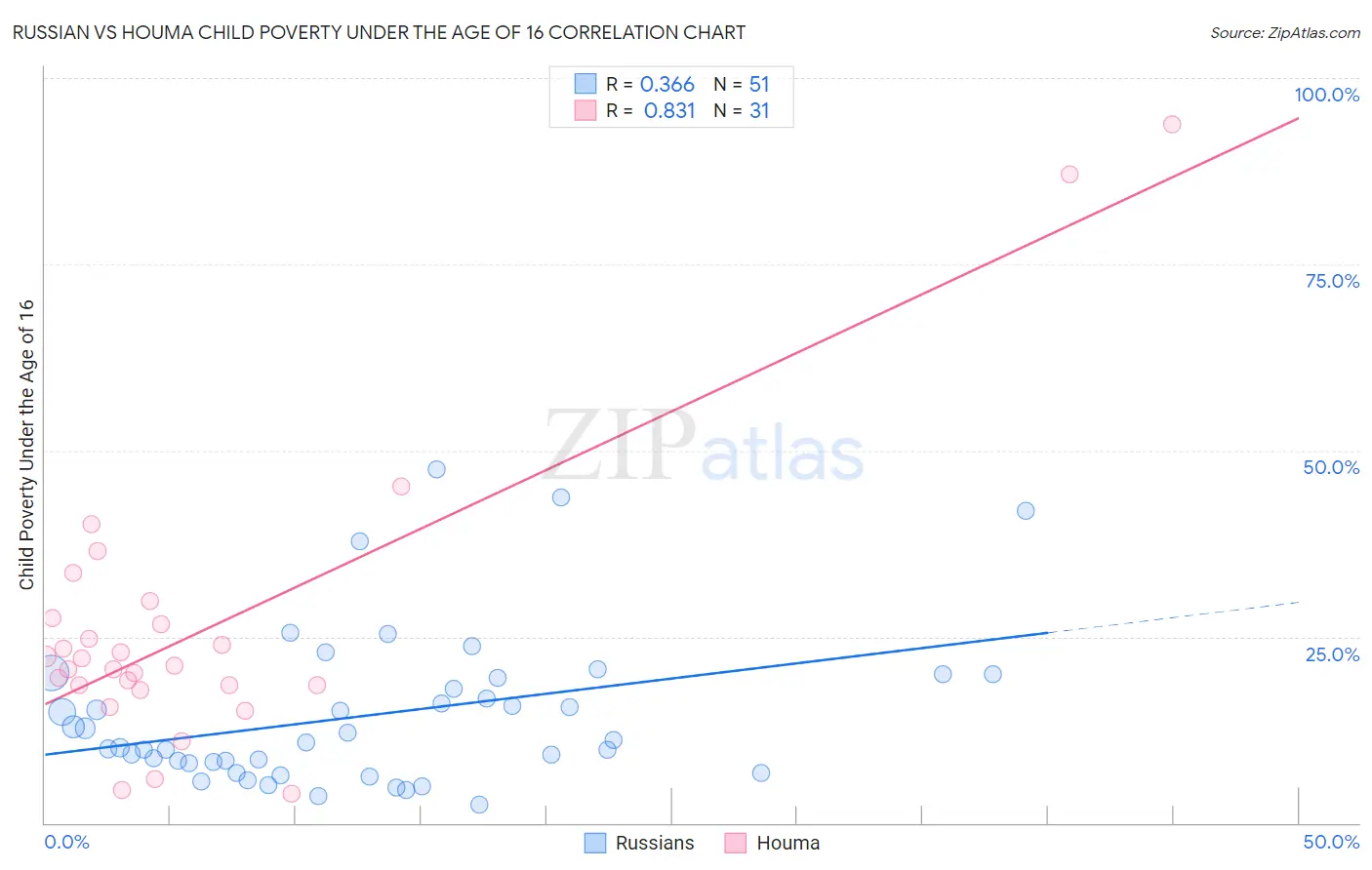Russian vs Houma Child Poverty Under the Age of 16
COMPARE
Russian
Houma
Child Poverty Under the Age of 16
Child Poverty Under the Age of 16 Comparison
Russians
Houma
13.5%
CHILD POVERTY UNDER THE AGE OF 16
99.6/ 100
METRIC RATING
34th/ 347
METRIC RANK
24.9%
CHILD POVERTY UNDER THE AGE OF 16
0.0/ 100
METRIC RATING
335th/ 347
METRIC RANK
Russian vs Houma Child Poverty Under the Age of 16 Correlation Chart
The statistical analysis conducted on geographies consisting of 502,911,881 people shows a mild positive correlation between the proportion of Russians and poverty level among children under the age of 16 in the United States with a correlation coefficient (R) of 0.366 and weighted average of 13.5%. Similarly, the statistical analysis conducted on geographies consisting of 36,741,016 people shows a very strong positive correlation between the proportion of Houma and poverty level among children under the age of 16 in the United States with a correlation coefficient (R) of 0.831 and weighted average of 24.9%, a difference of 84.1%.

Child Poverty Under the Age of 16 Correlation Summary
| Measurement | Russian | Houma |
| Minimum | 2.4% | 3.9% |
| Maximum | 47.5% | 93.9% |
| Range | 45.0% | 89.9% |
| Mean | 14.4% | 26.1% |
| Median | 10.8% | 21.1% |
| Interquartile 25% (IQ1) | 8.1% | 18.5% |
| Interquartile 75% (IQ3) | 19.4% | 27.6% |
| Interquartile Range (IQR) | 11.4% | 9.1% |
| Standard Deviation (Sample) | 10.3% | 19.5% |
| Standard Deviation (Population) | 10.2% | 19.2% |
Similar Demographics by Child Poverty Under the Age of 16
Demographics Similar to Russians by Child Poverty Under the Age of 16
In terms of child poverty under the age of 16, the demographic groups most similar to Russians are Lithuanian (13.5%, a difference of 0.20%), Asian (13.5%, a difference of 0.28%), Immigrants from Northern Europe (13.6%, a difference of 0.44%), Immigrants from Bolivia (13.6%, a difference of 0.46%), and Tongan (13.4%, a difference of 0.76%).
| Demographics | Rating | Rank | Child Poverty Under the Age of 16 |
| Immigrants | China | 99.8 /100 | #27 | Exceptional 13.3% |
| Assyrians/Chaldeans/Syriacs | 99.7 /100 | #28 | Exceptional 13.3% |
| Swedes | 99.7 /100 | #29 | Exceptional 13.3% |
| Turks | 99.7 /100 | #30 | Exceptional 13.4% |
| Danes | 99.7 /100 | #31 | Exceptional 13.4% |
| Tongans | 99.7 /100 | #32 | Exceptional 13.4% |
| Asians | 99.6 /100 | #33 | Exceptional 13.5% |
| Russians | 99.6 /100 | #34 | Exceptional 13.5% |
| Lithuanians | 99.6 /100 | #35 | Exceptional 13.5% |
| Immigrants | Northern Europe | 99.6 /100 | #36 | Exceptional 13.6% |
| Immigrants | Bolivia | 99.6 /100 | #37 | Exceptional 13.6% |
| Luxembourgers | 99.5 /100 | #38 | Exceptional 13.6% |
| Immigrants | Australia | 99.5 /100 | #39 | Exceptional 13.6% |
| Immigrants | Scotland | 99.4 /100 | #40 | Exceptional 13.7% |
| Croatians | 99.4 /100 | #41 | Exceptional 13.8% |
Demographics Similar to Houma by Child Poverty Under the Age of 16
In terms of child poverty under the age of 16, the demographic groups most similar to Houma are Yup'ik (25.1%, a difference of 1.1%), Sioux (25.2%, a difference of 1.4%), Black/African American (24.4%, a difference of 1.7%), Cheyenne (25.4%, a difference of 2.1%), and Immigrants from Dominican Republic (24.0%, a difference of 3.7%).
| Demographics | Rating | Rank | Child Poverty Under the Age of 16 |
| Colville | 0.0 /100 | #328 | Tragic 23.0% |
| Dominicans | 0.0 /100 | #329 | Tragic 23.8% |
| Natives/Alaskans | 0.0 /100 | #330 | Tragic 23.8% |
| Apache | 0.0 /100 | #331 | Tragic 23.8% |
| Pueblo | 0.0 /100 | #332 | Tragic 23.9% |
| Immigrants | Dominican Republic | 0.0 /100 | #333 | Tragic 24.0% |
| Blacks/African Americans | 0.0 /100 | #334 | Tragic 24.4% |
| Houma | 0.0 /100 | #335 | Tragic 24.9% |
| Yup'ik | 0.0 /100 | #336 | Tragic 25.1% |
| Sioux | 0.0 /100 | #337 | Tragic 25.2% |
| Cheyenne | 0.0 /100 | #338 | Tragic 25.4% |
| Crow | 0.0 /100 | #339 | Tragic 26.0% |
| Hopi | 0.0 /100 | #340 | Tragic 27.1% |
| Yuman | 0.0 /100 | #341 | Tragic 28.9% |
| Pima | 0.0 /100 | #342 | Tragic 29.0% |